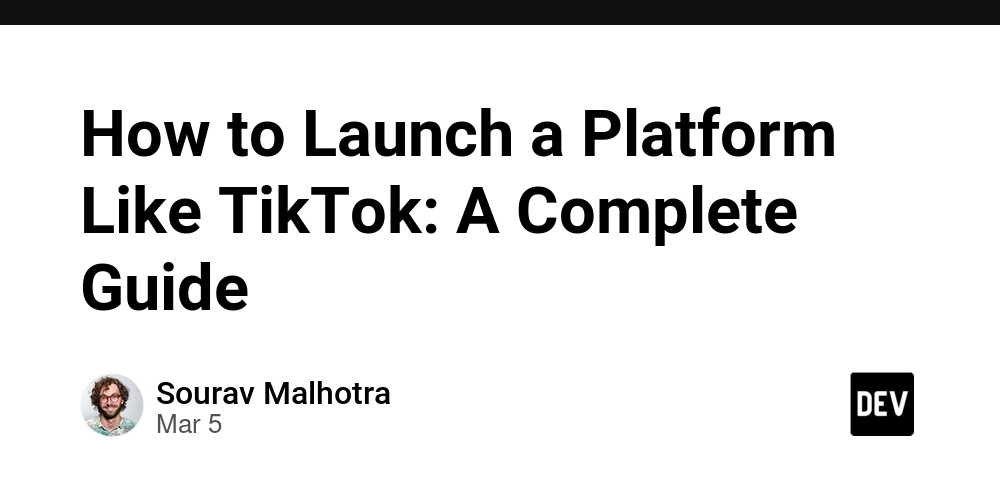How to Launch a Platform Like TikTok: A Complete Guide
Introduction TikTok has revolutionized the social media landscape with its short-form video content, viral challenges, and AI-driven personalization. If you're looking to launch a platform like TikTok, understanding its core functionalities, monetization strategies, and competitive landscape is crucial. This guide provides an in-depth analysis of building a short-video platform, including features, development steps, and a competitor comparison. Key Features of a TikTok-Like Platform User-Friendly Interface A seamless, intuitive UI that enhances user engagement is essential. Short-Form Video Upload & Editing AI-powered video filters and effects Speed control for slow-motion and fast-motion videos AR/VR features for interactive content Music & Sound Integration Licensed music library Voice-over and sound effects AI-Driven Recommendation System Machine learning algorithms to personalize content Analyzing user behavior and preferences Live Streaming & Monetization Live chat and virtual gifting options In-app purchases for exclusive content Engagement Features Hashtags, challenges, and trends Duet and collaboration options Monetization Strategies Advertisements (in-feed, banner, and branded content) Subscription models and premium features Virtual gifts and tipping system Steps to Launch a TikTok-Like Platform Step 1: Market Research & Competitor Analysis Analyze industry leaders like TikTok, Instagram Reels, and YouTube Shorts to understand their strengths and weaknesses. Step 2: Define Your Unique Value Proposition (UVP) Differentiate your platform by offering exclusive features like: AI-enhanced video analytics Decentralized content ownership Crypto-based incentives for creators Step 3: Choose the Right Tech Stack Front-End Technologies: React Native (for cross-platform apps) Flutter (for faster UI development) Back-End Technologies: Node.js / Python for server-side programming AWS / Google Cloud for storage and scalability Database Management: PostgreSQL / MongoDB for handling high-volume data Step 4: Develop the Core Functionalities Secure user authentication Video upload, compression, and streaming AI-based content recommendations Content moderation & reporting system Step 5: Beta Testing & User Feedback Soft launch with a limited audience Gather feedback and improve UI/UX Step 6: Marketing & Growth Strategies Influencer collaborations Hashtag challenges and viral campaigns App store optimization (ASO) Top Competitors & Their Unique Selling Points Platform Unique Features TikTok AI-driven recommendations, viral challenges Instagram Reels Integration with Instagram's ecosystem YouTube Shorts Leverages YouTube’s existing user base Triller Focus on music video creation Likee AR effects and virtual gifts Challenges in Building a TikTok Alternative High Development Costs: AI and video processing require significant investment. Regulatory & Legal Compliance: Data privacy laws (GDPR, CCPA) must be met. User Acquisition: Competing against established platforms requires strong marketing. FAQs How much does it cost to develop a platform like TikTok? Development costs range from $50,000 to $250,000, depending on features and technology. How long does it take to build a TikTok-like app? A fully functional MVP (Minimum Viable Product) takes around 6-12 months. How can I monetize a TikTok alternative? You can monetize through ads, subscriptions, virtual gifts, and branded content partnerships. Do I need a license for music integration? Yes, acquiring proper music licenses from record labels or using royalty-free music is essential. What is the best programming language for developing a short-video app? Popular choices include Swift (iOS), Kotlin (Android), and React Native for cross-platform apps. Conclusion Launching a platform like TikTok requires careful planning, investment, and differentiation. By incorporating advanced AI-driven features, innovative monetization models, and a strong marketing strategy, you can create a competitive short-video app. With the right execution, your platform can become the next big sensation in the social media space.

Introduction
TikTok has revolutionized the social media landscape with its short-form video content, viral challenges, and AI-driven personalization. If you're looking to launch a platform like TikTok, understanding its core functionalities, monetization strategies, and competitive landscape is crucial. This guide provides an in-depth analysis of building a short-video platform, including features, development steps, and a competitor comparison.
Key Features of a TikTok-Like Platform
- User-Friendly Interface
A seamless, intuitive UI that enhances user engagement is essential.
- Short-Form Video Upload & Editing
AI-powered video filters and effects
Speed control for slow-motion and fast-motion videos
AR/VR features for interactive content
- Music & Sound Integration
Licensed music library
Voice-over and sound effects
- AI-Driven Recommendation System
Machine learning algorithms to personalize content
Analyzing user behavior and preferences
- Live Streaming & Monetization
Live chat and virtual gifting options
In-app purchases for exclusive content
- Engagement Features
Hashtags, challenges, and trends
Duet and collaboration options
- Monetization Strategies
Advertisements (in-feed, banner, and branded content)
Subscription models and premium features
Virtual gifts and tipping system
Steps to Launch a TikTok-Like Platform
Step 1: Market Research & Competitor Analysis
Analyze industry leaders like TikTok, Instagram Reels, and YouTube Shorts to understand their strengths and weaknesses.
Step 2: Define Your Unique Value Proposition (UVP)
Differentiate your platform by offering exclusive features like:
AI-enhanced video analytics
Decentralized content ownership
Crypto-based incentives for creators
Step 3: Choose the Right Tech Stack
Front-End Technologies:
React Native (for cross-platform apps)
Flutter (for faster UI development)
Back-End Technologies:
Node.js / Python for server-side programming
AWS / Google Cloud for storage and scalability
Database Management:
PostgreSQL / MongoDB for handling high-volume data
Step 4: Develop the Core Functionalities
Secure user authentication
Video upload, compression, and streaming
AI-based content recommendations
Content moderation & reporting system
Step 5: Beta Testing & User Feedback
Soft launch with a limited audience
Gather feedback and improve UI/UX
Step 6: Marketing & Growth Strategies
Influencer collaborations
Hashtag challenges and viral campaigns
App store optimization (ASO)
Top Competitors & Their Unique Selling Points
Platform
Unique Features
TikTok
AI-driven recommendations, viral challenges
Instagram Reels
Integration with Instagram's ecosystem
YouTube Shorts
Leverages YouTube’s existing user base
Triller
Focus on music video creation
Likee
AR effects and virtual gifts
Challenges in Building a TikTok Alternative
High Development Costs: AI and video processing require significant investment.
Regulatory & Legal Compliance: Data privacy laws (GDPR, CCPA) must be met.
User Acquisition: Competing against established platforms requires strong marketing.
FAQs
- How much does it cost to develop a platform like TikTok?
Development costs range from $50,000 to $250,000, depending on features and technology.
- How long does it take to build a TikTok-like app?
A fully functional MVP (Minimum Viable Product) takes around 6-12 months.
- How can I monetize a TikTok alternative?
You can monetize through ads, subscriptions, virtual gifts, and branded content partnerships.
- Do I need a license for music integration?
Yes, acquiring proper music licenses from record labels or using royalty-free music is essential.
- What is the best programming language for developing a short-video app?
Popular choices include Swift (iOS), Kotlin (Android), and React Native for cross-platform apps.
Conclusion
Launching a platform like TikTok requires careful planning, investment, and differentiation. By incorporating advanced AI-driven features, innovative monetization models, and a strong marketing strategy, you can create a competitive short-video app. With the right execution, your platform can become the next big sensation in the social media space.












































































































































































![[The AI Show Episode 142]: ChatGPT’s New Image Generator, Studio Ghibli Craze and Backlash, Gemini 2.5, OpenAI Academy, 4o Updates, Vibe Marketing & xAI Acquires X](https://www.marketingaiinstitute.com/hubfs/ep%20142%20cover.png)



























































































































![[DEALS] The Premium Learn to Code Certification Bundle (97% off) & Other Deals Up To 98% Off – Offers End Soon!](https://www.javacodegeeks.com/wp-content/uploads/2012/12/jcg-logo.jpg)


![From drop-out to software architect with Jason Lengstorf [Podcast #167]](https://cdn.hashnode.com/res/hashnode/image/upload/v1743796461357/f3d19cd7-e6f5-4d7c-8bfc-eb974bc8da68.png?#)








































































































.png?#)

































_Christophe_Coat_Alamy.jpg?#)
 (1).webp?#)





































































































![Apple Considers Delaying Smart Home Hub Until 2026 [Gurman]](https://www.iclarified.com/images/news/96946/96946/96946-640.jpg)
![iPhone 17 Pro Won't Feature Two-Toned Back [Gurman]](https://www.iclarified.com/images/news/96944/96944/96944-640.jpg)
![Tariffs Threaten Apple's $999 iPhone Price Point in the U.S. [Gurman]](https://www.iclarified.com/images/news/96943/96943/96943-640.jpg)




































































































































